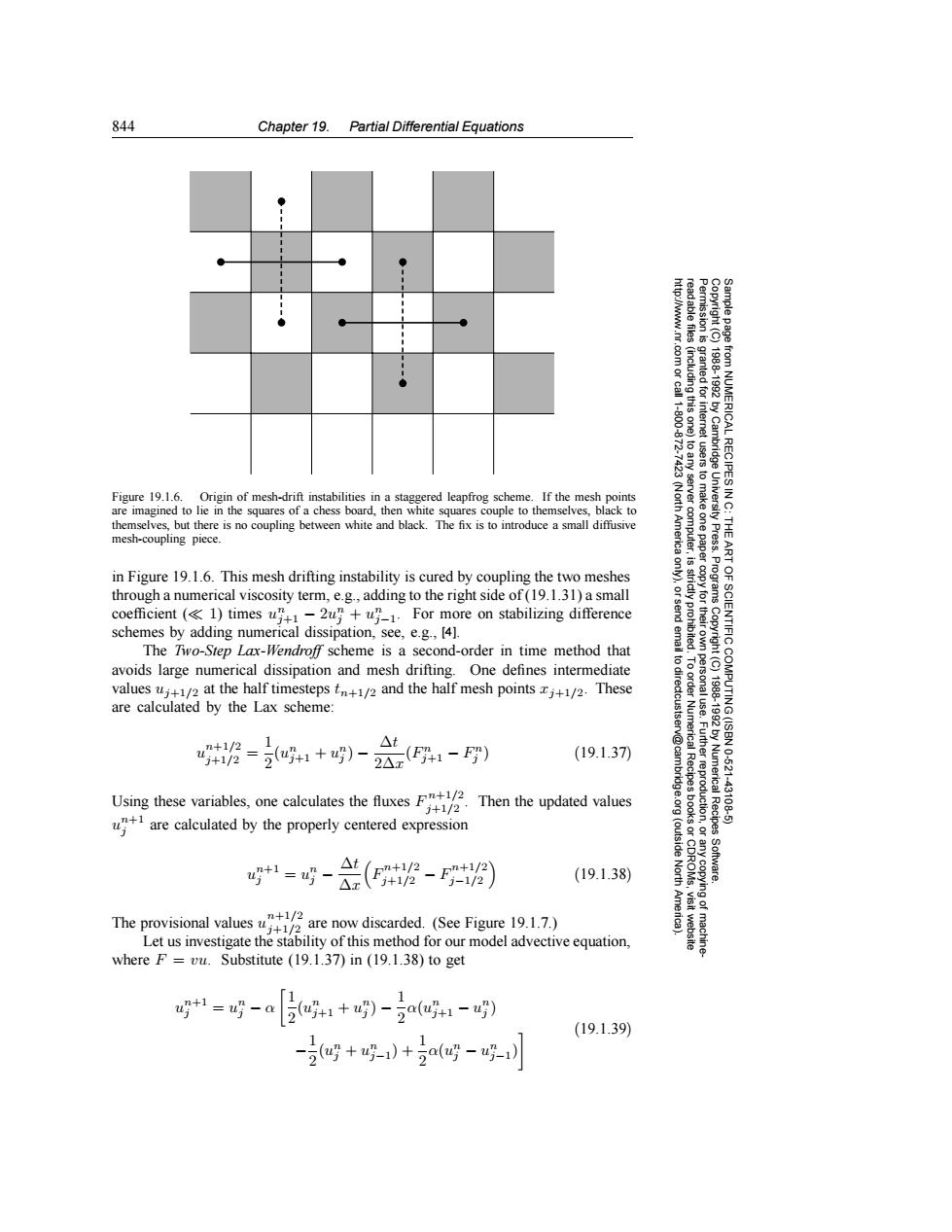正在加载图片...

844 Chapter 19.Partial Differential Equations ● .com or call 1-800-872- (including this one) /Cambridge from NUMERICAL RECIPES IN C: 19881992 Figure 19.1.6. Origin of mesh-drift instabilities in a staggered leapfrog scheme.If the mesh points (North server are imagined to lie in the squares of a chess board,then white squares couple to themselves,black to themselves,but there is no coupling between white and black.The fix is to introduce a small diffusive mesh-coupling piece. America computer, users to make one paper UnN电.t THE ART in Figure 19.1.6.This mesh drifting instability is cured by coupling the two meshes through a numerical viscosity term,e.g.,adding to the right side of(19.1.31)a small Programs coefficient (1)times u1-2u+u1.For more on stabilizing difference schemes by adding numerical dissipation,see,e.g.,[4]. The Two-Step Lax-Wendroff scheme is a second-order in time method that 三爱 avoids large numerical dissipation and mesh drifting.One defines intermediate values uj+1/2 at the half timestepstn+1/2 and the half mesh points j+1/2.These are calculated by the Lax scheme: OF SCIENTIFIC COMPUTING (ISBN un+1/2 △t +/=2+1+)-2△(野+1-) (19.1.37) Numerical 10-521 Using these variables,one calculates the fluxes j+1/2 Then the updated values 43106 are calculated by the properly centered expression uctio (outside Recipes (19.1.38) △x North Software. The provisional valuesar nw discarded.(Se Fiure 19.1.7.) Let us investigate the stability of this method for our model advective equation, where F vu.Substitute (19.1.37)in (19.1.38)to get u2+l ug -a [g+》-tg1-) (19.1.39 -吗+吗-+(吗--)844 Chapter 19. Partial Differential Equations Permission is granted for internet users to make one paper copy for their own personal use. Further reproduction, or any copyin Copyright (C) 1988-1992 by Cambridge University Press. Programs Copyright (C) 1988-1992 by Numerical Recipes Software. Sample page from NUMERICAL RECIPES IN C: THE ART OF SCIENTIFIC COMPUTING (ISBN 0-521-43108-5) g of machinereadable files (including this one) to any server computer, is strictly prohibited. To order Numerical Recipes books or CDROMs, visit website http://www.nr.com or call 1-800-872-7423 (North America only), or send email to directcustserv@cambridge.org (outside North America). Figure 19.1.6. Origin of mesh-drift instabilities in a staggered leapfrog scheme. If the mesh points are imagined to lie in the squares of a chess board, then white squares couple to themselves, black to themselves, but there is no coupling between white and black. The fix is to introduce a small diffusive mesh-coupling piece. in Figure 19.1.6. This mesh drifting instability is cured by coupling the two meshes through a numerical viscosity term, e.g., adding to the right side of (19.1.31) a small coefficient ( 1) times un j+1 − 2un j + un j−1. For more on stabilizing difference schemes by adding numerical dissipation, see, e.g., [4]. The Two-Step Lax-Wendroff scheme is a second-order in time method that avoids large numerical dissipation and mesh drifting. One defines intermediate values uj+1/2 at the half timesteps tn+1/2 and the half mesh points xj+1/2. These are calculated by the Lax scheme: un+1/2 j+1/2 = 1 2 (un j+1 + un j ) − ∆t 2∆x(F n j+1 − F n j ) (19.1.37) Using these variables, one calculates the fluxes F n+1/2 j+1/2 . Then the updated values un+1 j are calculated by the properly centered expression un+1 j = un j − ∆t ∆x F n+1/2 j+1/2 − F n+1/2 j−1/2 (19.1.38) The provisional values un+1/2 j+1/2 are now discarded. (See Figure 19.1.7.) Let us investigate the stability of this method for our model advective equation, where F = vu. Substitute (19.1.37) in (19.1.38) to get un+1 j = un j − α 1 2 (un j+1 + un j ) − 1 2 α(un j+1 − un j ) −1 2 (un j + un j−1) + 1 2 α(un j − un j−1) (19.1.39)